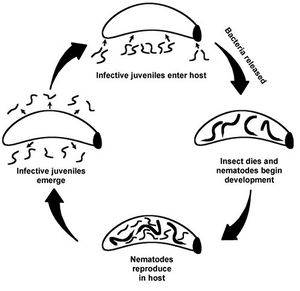Xenorhabdus nematophilus: Difference between revisions
No edit summary |
|||
| Line 13: | Line 13: | ||
==Biological Interaction== | ==Biological Interaction== | ||
[[Image:Shapiro.cornell.process.jpg|thumb|300px|left|The life cycle of the nematode is completed in a few days, and it results in thousands of new infective juveniles looking for hosts.]] | [[Image:Shapiro.cornell.process.jpg|thumb|300px|left|The life cycle of the nematode is completed in a few days, and it results in thousands of new infective juveniles looking for hosts. Source: http://www.biocontrol.entomology.cornell.edu/pathogens/nematodes.html]] | ||
Describe the physical and chemical characteristics of the environment, using as many sections/subsections as you require. If it is appropriate, you can divide the physical and chemical attributes of the environment into separate sections. Look at other topics available in MicrobeWiki. Which involve processes similar to yours? Create links where relevant. | Describe the physical and chemical characteristics of the environment, using as many sections/subsections as you require. If it is appropriate, you can divide the physical and chemical attributes of the environment into separate sections. Look at other topics available in MicrobeWiki. Which involve processes similar to yours? Create links where relevant. | ||
| Line 32: | Line 32: | ||
==Microbial communities, Key MicroOrganisms== | ==Microbial communities, Key MicroOrganisms== | ||
[[Image:Shapiro.cornell.jpg|thumb|300px|right| <b>A</b> Entomopathogenic nematode, infective juevenile stage. <b>B</b> Infected Galleria mellonella (wax moth) larva with nematodes emerging. Source: http://www.biocontrol.entomology.cornell.edu/pathogens/nematodes.html]] | |||
What kind of microbes do we typically find in this environment? Or associated with important processes in this environment? Describe key groups of microbes that we find in this environment, and any special adaptations they may have evolved to survive in this environment. | What kind of microbes do we typically find in this environment? Or associated with important processes in this environment? Describe key groups of microbes that we find in this environment, and any special adaptations they may have evolved to survive in this environment. | ||
List examples of specific microbes that represent key groups or are associated with important processes found in this environment. Link to other MicrobeWiki pages where possible. | List examples of specific microbes that represent key groups or are associated with important processes found in this environment. Link to other MicrobeWiki pages where possible. | ||
Revision as of 04:17, 8 April 2013
Introduction
Xenorhabdus nematophilus is a bacterium that exists in a symbiotic relationship with nematodes, of the genus Steinernema. The interaction is specific to each species. The are found in soil environments. Introduce the habitat, its ecological significance, and the importance of microorganisms in this environment. (What processes do they carry out? What functions do they perform?) What microbial processes define this environment? Describe microbial processes that are important in this habitat, adding sections/subsections as needed. Look at other topics in MicrobeWiki. Are some of these processes already described? Create links where relevant.
Subsection 1
Subsection 1a
Subsection 1b
Subsection 2
Biological Interaction

Describe the physical and chemical characteristics of the environment, using as many sections/subsections as you require. If it is appropriate, you can divide the physical and chemical attributes of the environment into separate sections. Look at other topics available in MicrobeWiki. Which involve processes similar to yours? Create links where relevant.
Subsection 1
Subsection 1a
Subsection 1b
Subsection 2
Niche, Physical environment
Describe the physical and chemical characteristics of the environment, using as many sections/subsections as you require. If it is appropriate, you can divide the physical and chemical attributes of the environment into separate sections. Look at other topics available in MicrobeWiki. Which involve processes similar to yours? Create links where relevant.
Subsection 1
Subsection 1a
Subsection 1b
Subsection 2
Microbial communities, Key MicroOrganisms

What kind of microbes do we typically find in this environment? Or associated with important processes in this environment? Describe key groups of microbes that we find in this environment, and any special adaptations they may have evolved to survive in this environment.
List examples of specific microbes that represent key groups or are associated with important processes found in this environment. Link to other MicrobeWiki pages where possible.
Are there important biological interactions that are important in this environment? Do these interactions influence microbial populations and their activities? How do these interactions influence other organisms? Describe biological interactions that might take place in this environment, using as many sections/subsections as you require. Look at other topics available in MicrobeWiki. Create links where relevant.
Subsection 1
Subsection 1a
Subsection 1b
Subsection 2
Microbial processes
What microbial processes define this environment? Describe microbial processes that are important in this habitat, adding sections/subsections as needed. Look at other topics in MicrobeWiki. Are some of these processes already described? Create links where relevant.
Subsection 1
Subsection 1a
Subsection 1b
Subsection 2
Current Research
Enter summaries of recent research here--at least three required
References
Edited by <Chloe M. Mattia>, a student of Angela Kent at the University of Illinois at Urbana-Champaign.
